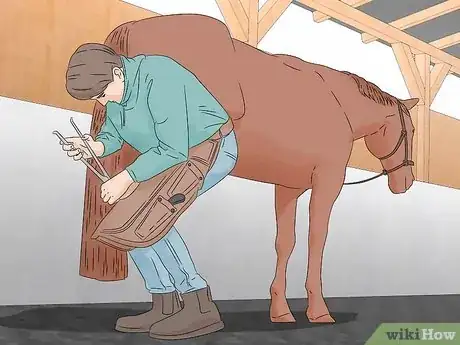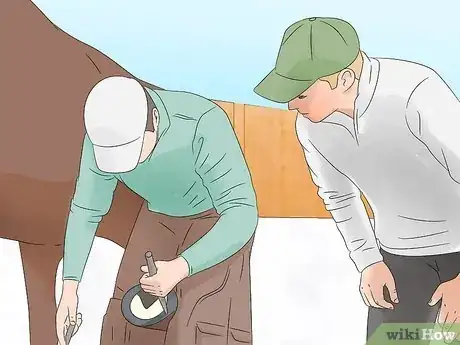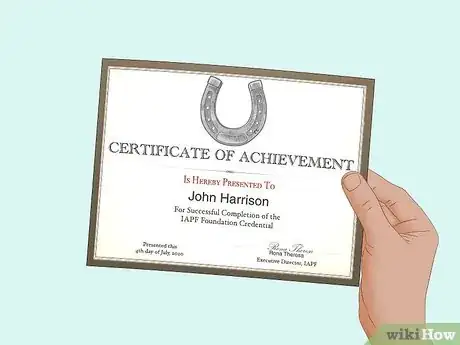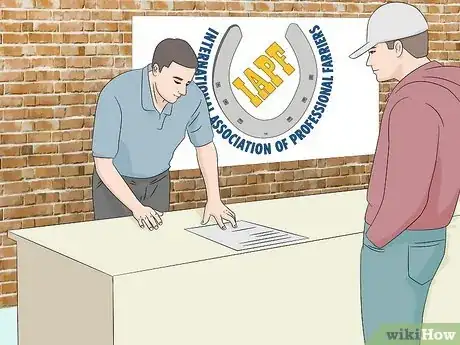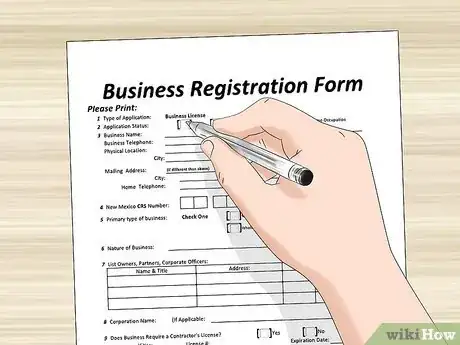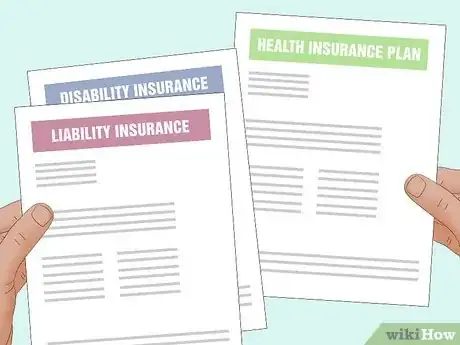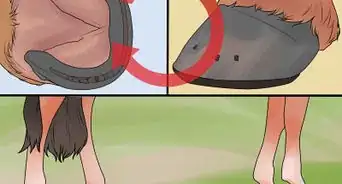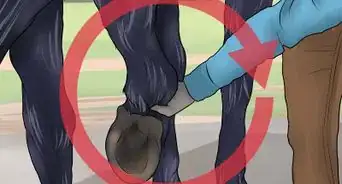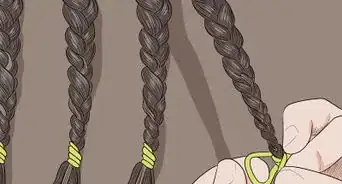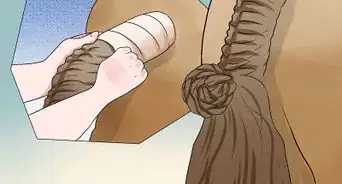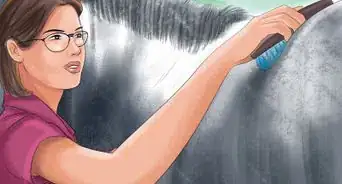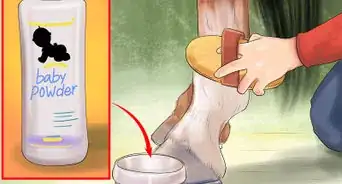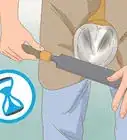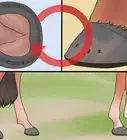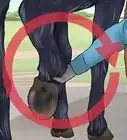This article was co-authored by Kate Jutagir and by wikiHow staff writer, Sophia Latorre. Kate Jutagir is an Equestrian Specialist, Hunter/Jumper Trainer, and the Owner of Blackhound Equestrian, a premier training barn located on 65 acres in Castro Valley, California. Originally designed to be a riding school used as a springboard for dedicated students into careers in the sport, Blackhound Equestrian has grown into a hunter/jumper training program for all levels focusing on providing a solid foundation needed for personal advancement in the sport. Kate has over 25 years of equestrian instruction and training experience. Her focus on developing horse and rider partnerships provides a complete equestrian education for both beginners and advanced riders alike.
There are 14 references cited in this article, which can be found at the bottom of the page.
This article has been viewed 52,320 times.
Do you love working with horses? Are you interested in blacksmithing? If so, a farrier might be the perfect job for you. While you technically only need a high school diploma to become a farrier, the best career path is to pursue training at a professional farrier school, complete an apprenticeship, and get certified.[1] We’re here to walk you through all the ins and outs of becoming a farrier so you can get started today.
Steps
Training to Be a Farrier
-
1Shadow a farrier to make sure this is the path you want to take. Shadowing a farrier can give you an excellent idea of what the work entails.[3] Find a farrier in your area and ask to go along with them for a day to see what the work is like. Try to find an experienced farrier so that you can ask questions, such as:
- What is the most challenging part of your job?
- How many clients do you visit each week?
- What is a typical day like for you?
-
2Apply to an accredited farrier or horseshoeing school. It is important to find a school that is accredited so that your coursework will be acknowledged by any professional organizations that you wish to join. Attending a farrier school can also speed up your path to becoming a professional farrier.[4] Some schools offer programs that you can complete in a few months rather than a few years.
- You might also want to consider programs that pair business courses with the farrier coursework in order to increase your chances of running a successful business when you graduate.
- Find a list of farrier schools in the U.S. at https://professionalfarriers.com/farrier_schools.php.
-
3Complete the coursework to the best of your ability. Coursework for farriers is often completed alongside practical experiences, such as forge work and horseshoeing. Course work for farriers often includes things like:[5]
- Horse anatomy
- Veterinary care
- Shoeing horses
- Making tools
- Welding
-
4Complete an apprenticeship. An apprenticeship provides hands-on job experience under the supervision of an experienced farrier.[6] Depending on the requirements of your training program, you may complete an apprenticeship alongside your coursework, in place of coursework, or after completing your coursework.
- A four-year apprenticeship with an Accredited Training Farrier (ATF) is required to work as a farrier in the United Kingdom. During the apprenticeship, you are required to complete coursework and take exams.[7]
- If you choose not to attend a farrier school, you could potentially become a farrier in the United States after completing an apprenticeship with an experienced farrier.[8]
-
5Get certified. Certification is required to work as a farrier in the United Kingdom, but it is not required in the United States. However, it’s recommended to get a farrier certification even if your country doesn’t require it. Getting certified not only sets you apart from your competitors, but also ensures that you have all the skills necessary to run a successful business.[9]
- In the United States, the American Farriers Association offers 3 levels of certification: Certified Farrier (AFA CF), Certified Tradesman Farrier (AFA CTF), and Certified Journeyman Farrier (AFA CJF).
-
6Join professional farrier associations. Professional associations can help you network in your industry as well as continue your education as a farrier. Check out the American Farrier’s Association, International Association of Professional Farriers, Guild of Professional Farriers, American Association of Professional Farriers, Inc., American Association of Equine Practitioners, and Equine Science Society, as well as local associations.
Starting Your Own Farrier Business
-
1Create a business plan. Use your business plan to map out your vision for your future.[12] Include information about your business structure, the market for your business, start-up costs, and operational details.[13]
- If you need financing to start your business, a business plan is essential.
-
2Register your business. If you plan to do business under a special name rather than using your own name, register your business for state and federal tax purposes.[14] For example, if you plan to do business under the name “Friendly Farrier Service,” then visit your local clerk’s office to register this name.
- License your business if necessary. Depending on your state’s laws, you may need to obtain a license for your business as well.[15]
-
3Get health, disability, and liability insurance. Being a farrier can be dangerous because you are working closely with horses as well as doing other dangerous tasks, like forging and welding. Before you start working, ensure that you are well covered in the event of an accident.[16]
- Health insurance is extremely important for farriers. Don’t opt for the bare minimum insurance options if you can help it. It is likely that you will need to use your insurance at some point, so paying a bit more every month is better than having to pay a lot more out of pocket if you get seriously injured.
- Disability insurance will provide you with some security in case you are injured and cannot work for a while.
- Liability insurance provides some protection for you in case one of your customers is injured or if their property (including the horse) is damaged by you or as a result of your work.
-
4Build your client base. When you’re first starting out, look for clients at horse shows, hand out business cards, and ask other farriers if there are clients they can’t accommodate that they could refer to you. In most cases, you’ll gain clients by word of mouth, so it’s important to build a good reputation as a farrier by providing excellent service to your new and existing clients.
- You may want to work as an assistant to an experienced farrier until you have enough clients of your own to support a business.
- Do your best to maintain good relationships with your clients, such as by showing up on time for your appointments and listening to your clients’ needs.
- Build relationships with local equine veterinarians so you can refer clients to each other.
-
5Continue to gain knowledge of your trade. Continuing education is essential for your success as a farrier.[17] Don’t end your education with a basic certification! Keep learning about your trade and gain as many certifications as you can.
- Stay up to date on new developments within your trade. Subscribe to industry publications.
- Attend clinics, conferences, horse shows, and other equine events.
- Take advanced courses and challenge yourself to apply for advanced certifications as well.
Community Q&A
-
QuestionCan I be a farrier if I’m a girl?
 wikiHow Staff EditorThis answer was written by one of our trained team of researchers who validated it for accuracy and comprehensiveness.
wikiHow Staff EditorThis answer was written by one of our trained team of researchers who validated it for accuracy and comprehensiveness.
Staff Answer wikiHow Staff EditorStaff AnswerOf course you can! Anyone with the desire, drive, and training can become a farrier, regardless of gender.
wikiHow Staff EditorStaff AnswerOf course you can! Anyone with the desire, drive, and training can become a farrier, regardless of gender. -
QuestionI am 28 and Live in Bury/Manchester and want to become a farrier, how do I do this?
 Community AnswerSee what qualifications you need and apply to colleges or apprenticeships. There is a college in Wales that offers farrier courses.
Community AnswerSee what qualifications you need and apply to colleges or apprenticeships. There is a college in Wales that offers farrier courses. -
QuestionHow old do I have to be to become a farrier?
 Community AnswerThis may depend on your state. If you are under 18 (or 16, depending on your region) years of age, consider looking at the local laws.
Community AnswerThis may depend on your state. If you are under 18 (or 16, depending on your region) years of age, consider looking at the local laws.
Warnings
- Never try to perform the work of a farrier without proper training! You could seriously injure yourself or the horse. Go through training and seek the guidance of an experienced farrier before attempting to clean, change, or remove horseshoes.⧼thumbs_response⧽
References
- ↑ https://agexplorer.ffa.org/career/farrier
- ↑ https://www.thefarrierguide.com/p/what-does-farrier-do.html
- ↑ https://www.thefarrierguide.com/2014/07/uncertified-what-farrier-certification.html
- ↑ https://bluecollarbrain.com/how-to-become/farrier/
- ↑ https://nationalcareersservice.direct.gov.uk/advice/planning/jobprofiles/Pages/farrier.aspx
- ↑ https://www.thefarrierguide.com/p/farrier-apprenticeships.html
- ↑ https://nationalcareersservice.direct.gov.uk/advice/planning/jobprofiles/Pages/farrier.aspx
- ↑ https://equimed.com/health-centers/hoof-care/articles/what-kind-of-training-does-a-farrier-have
- ↑ https://www.thefarrierguide.com/2014/07/uncertified-what-farrier-certification.html
- ↑ https://www.ziprecruiter.com/Salaries/What-Is-the-Average-Farrier-Salary-by-State
- ↑ https://www.thefarrierguide.com/p/average-farrier-salary.html
- ↑ https://www.thefarrierguide.com/p/how-to-start-farrier-business.html
- ↑ https://www.entrepreneur.com/article/247575
- ↑ https://www.irs.gov/businesses/small-businesses-self-employed/state-and-federal-online-business-registration
- ↑ https://www.thefarrierguide.com/p/how-to-start-farrier-business.html
- ↑ https://www.thefarrierguide.com/p/how-to-start-farrier-business.html
- ↑ https://pubmed.ncbi.nlm.nih.gov/22981189/
